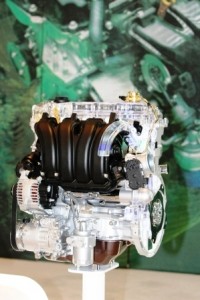A revised four-cylinder engine, dubbed Theta II, started production at Hyundai’s Motor Manufacturing of Alabama assembly plant this week. The 2.4-liter gasoline engine adds direct fuel injection and other revisions to the Korean-designed and manufactured Theta engine.
Theta currently is produced in Namyang, Korea at volumes of more than 2 million units annually, with an emphasis on exports.
Theta II adds gasoline direct injection (GDI) and a variable induction system to produce 200 horsepower at 6,300 rpm and 186 pound-feet of torque at 4,250 rpm. This results in an increase of 25 horsepower and 18 pound-feet of torque when compared with the older design. More telling, perhaps, is the excellent specific output of 85 horsepower/liter in a naturally aspirated engine.
In the next Sonata, Hyundai claims that the EPA certification now underway will result in a 35 mpg highway rating, which would be the highest in the class.

Direct News Injection!
Hyundai announced late in 2008 that it would lead the industry with the then newly proposed CAFE standards of 35 mg by 2020. It would accomplish this by achieving that efficiency level five years earlier in 2015. The plans put in place then to do this have served the Korean maker well, and, potentially, gives it another marketing advantage besides its 120,000-mile engine warranty.
Since then, of course, CAFE standards have been revised under the Obama Administration to 35.5 mpg by 2016, and most — if not all –automakers are now pursuing the same technologies that Theta II uses.
Hyundai now says it will meet these newly toughened standards ahead of time, and holds to its promise to become the most fuel-efficient brand in the U.S.
However, the latest EPA fuel-economy trend report shows that differences among makers are decreasing, a development EPA expects to continue. We’ll have to wait and see.
Theta II has a unique engine block, intake manifold, domed pistons, crankshaft and connecting rods, among other significant revisions. Four individual fuel injectors spray gasoline at pressures up to 2117 psi (150 bar) directly into thecombustion chamber. The relatively high, 11.3:1, compression ratio contributes to raising the engine’s output and efficiency.
Fuel injection is “split timed” in two phases during a cold start. First, as usual, fuel is sprayed during the piston’s intake stroke. However, another shot of fuel is added at the end of the compression stroke. Split injection warms the catalytic converter to operating temperature sooner, and as a result, Theta II meets the California Air Resources Board ULEV-2 and PZEV standards.
Hyundai claims that compared to a conventional non-DI engine of the same size, GDI returns 7% more torque at lower engine speeds, and 12% more torque at higher speeds. Gas mileage is said to be improved by as much as 10%.

